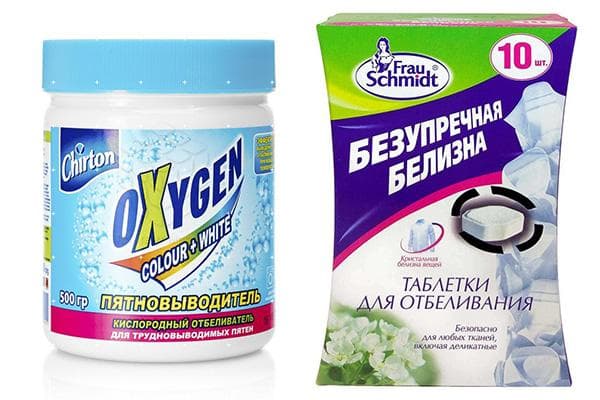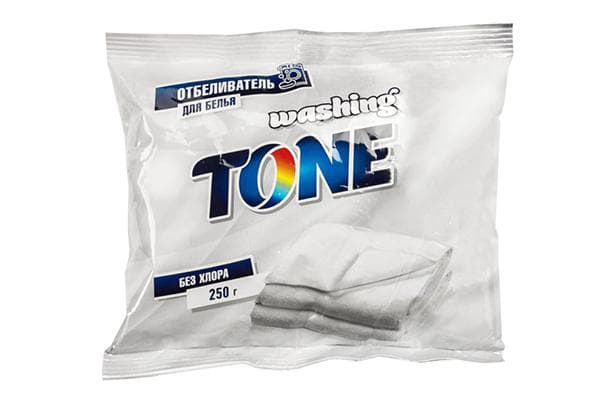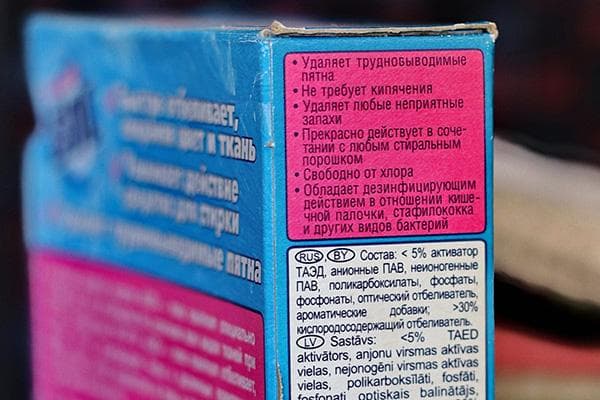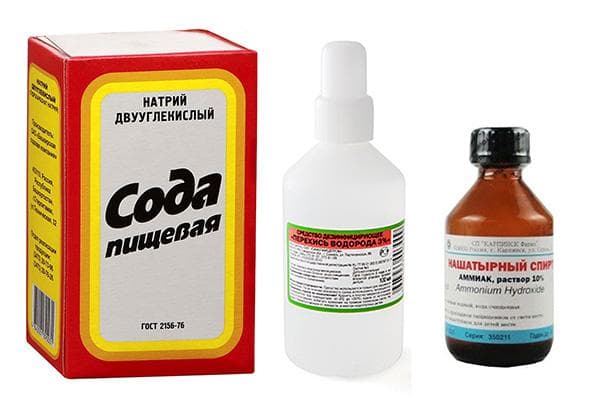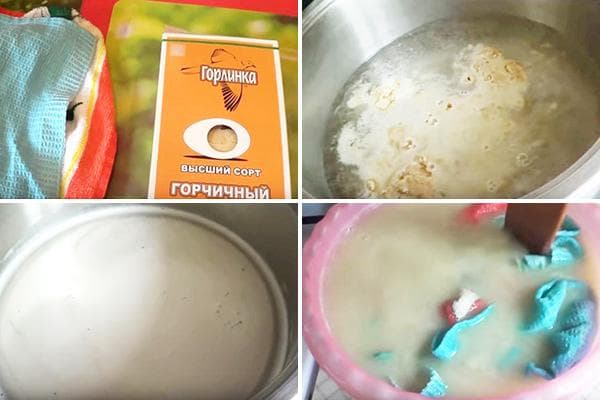How to effectively bleach gray, washed laundry?
Snow-white tablecloths, sheets and napkins, shining with pristine cleanliness, testify like nothing else to the hard work and neatness of the hostess. You can bleach your laundry effectively and quickly using both chemical bleaches and inexpensive improvised means: soda, peroxide, aspirin and many others.
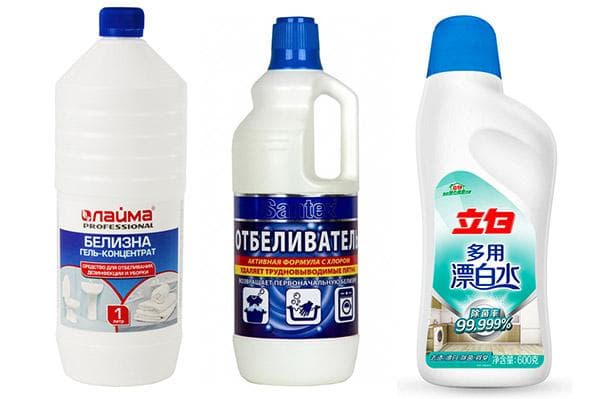
Industrial bleaches
Often, buying white things, be it a sheet, tablecloth, T-shirt or underwear, does not meet with much enthusiasm from the owner - and is absolutely in vain. It is much easier to restore the original whiteness of white products than to wash colored textiles. It is enough to study the composition of the material and choose the appropriate bleach: with chlorine, with active oxygen or optical. Fortunately, today these products are presented in a huge assortment in any hardware store.
Chlorine-containing
Chlorine bleach is good for whites made from 100% cotton and linen and is not suitable for wool, silk and other delicate materials. The basis of such detergents is sodium hypochlorite. In addition, the composition contains surfactants, sodium hydroxide and sodium carbonate.
The main advantages of chlorine-containing bleaches are low cost, fast action, and removal of contaminants regardless of the type of origin. However, if this aggressive product is used frequently, holes and gaps may appear on the fabric, and whitish stains may form when the chemical comes into contact with colored clothing.In addition, bleach has an unpleasant, pungent odor and is not suitable for machine washing.
The following preparations are especially popular among buyers who prefer chlorine compounds:
- "White". The product does an excellent job of whitening and disinfecting laundry even in cold water. For 10 liters of water take 2 tbsp. l. solution, stir and immerse white items for 20–30 minutes, then rinse several times with cool water. Whiteness can also be added by boiling. The cost of 1 liter is 50 rubles.
- Liby. Bleach produced in China will quickly restore the white color, make things soft, and destroy bacteria and harmful microorganisms that cause the smell of sweat. At the same time, the product is ineffective when washing in cold water and smells strongly of bleach. Recommended for use at +60°C. The cost of 1.5 liters is 365 rubles.
- Santex. Active chlorine will allow you to remove even stubborn stains and get rid of the yellowness and grayness of white fabrics. Restores the radiant whiteness and freshness of cotton fabrics. The cost of 1 liter is 55 rubles.
When working with chlorine bleach, be sure to protect your hands with rubber gloves.
Oxygen-containing
Bleach with active oxygen belongs to the new generation of detergents. They do an excellent job of restoring the whiteness of both synthetic and natural materials, and act carefully and effectively.
The principle of operation of this bleach is very simple. When the chemical interacts with water, active oxygen is released, which acts on the dirt as an oxidizing agent, removing stains and gray stains. As a result, the laundry becomes clean and amazingly white again, while the fabric does not fall apart and smells pleasant.
Available in the form of a solution, tablets or powder, used for hand and machine washing.
- Chirton Oxygen. Bleach was produced in the Czech Republic. Bleach composition: oxygen-based bleaching reagents (>30%), anionic and nonionic surfactants. Active oxygen removes even the most difficult stains and dirt from textiles. Suitable for any fabric. Performed well when washed in cold water. The cost of 500 g is 160 rubles.
- FRAU SCHMIDT. Bleach tablets from Israeli manufacturers, designed specifically for whitening white curtains, tulle, and bathroom curtains. Completely restores whiteness and brightness of color. Suitable for a variety of fabrics including muslin and voile. Cost 5 tab. - 320 rubles.
- Washing Tone. Designed for cleaning cotton, linen, synthetic fabrics, fabrics made of mixed fibers (except for products made from natural silk and wool). The product effectively removes complex stains. The cost of 500 g is 75 rubles.
Optical
The principles of operation of optical brightener are fundamentally different from the operation of chlorine and oxygen preparations. These products contain special luminescent additives, the smallest particles of which remain on the surface of the white material after washing and create the illusion of dazzling whiteness. Moreover, if you go outside in a T-shirt washed with optical bleach on a sunny day, it will seem even whiter than indoors, since the effect of using bleach is especially noticeable when exposed to ultraviolet radiation.
Since optical brightener by itself does not clean clothes, it is not produced separately, but is included in laundry detergent or soap.Those who are interested in this innovation should pay attention to the fact that after the next wash with regular powder, white laundry will again become grayish.
Folk remedies and methods
If you don’t have the opportunity or desire to buy industrial bleach, you can use improvised means, including baking soda, salt, aspirin and even vegetable oil.
- Soda
Regular baking soda in combination with ammonia will return the whiteness to washed and grayed items that have turned gray from long-term use. The soaking solution is prepared according to the following recipe: take 3 tbsp for 3 liters of water. l. soda and 1 tbsp. l. ammonia. Textiles are immersed in the prepared mixture and left for 3 hours, after which they are rinsed. This method is great for washing children's clothes, since soda does not cause allergies and does not damage the fabric.
- Ammonia
White linen or cotton items that have turned yellow from age can be “brought back to life” with the help of ammonia. To do this, dissolve washing powder or gel in hot water and add 2 tbsp. l. ammonia and soak the products for a few minutes.
- Hydrogen peroxide
To bleach delicate fabrics, wool and silk, you can use hydrogen peroxide. Add 1 tbsp to 5 liters of water. l. peroxide and 5 tbsp. l. table salt and soak the clothes in this solution for at least 3 hours, after which they are washed in a machine or by hand.
- Mustard
Table linen, napkins and towels, which usually have greasy stains, can be perfectly whitened using mustard powder. For this, 1 tbsp. l. dry mustard, pour 1 liter of hot water, let it settle, then pour the settled water into another container and soak the laundry for 3-5 hours.At the end of the work, things should be thoroughly washed with regular powder.
- Boric acid
For whitening with this antiseptic drug, the solution is prepared at the rate of 2 tsp. boric acid per 1 liter of water. The mixture is perfect for washing white socks, T-shirts, T-shirts and other, including children's, underwear. Things can be soaked for 30 minutes, and then washed as usual or boiled by adding washing powder and boric acid.
- Vegetable oil
Dirty kitchen towels can be washed using vegetable oil. To do this, they need to be soaked for 10–12 hours in a solution prepared from 3 liters of water, 2 tbsp. l. butter, 2 tbsp. l. powder and 2 tbsp. l. any bleach, and then wash and rinse thoroughly.
- Acetylsalicylic acid
You can remove stubborn stains and restore the whiteness of fabrics with the help of this popular drug. Aspirin is especially good for removing yellow stains from sweat in the armpits. The tablets are diluted with warm water and soaked in clothes. The more tablets, the higher the concentration of the resulting solution, and therefore the strength of the product.
- Eggshell
Since ancient times, chicken egg shells have been used to whiten clothes. It must be thoroughly crushed, collected in a fabric bag, tied well and placed in the drum of the washing machine. 100 g of shells is enough for one wash.
- Boiling
Another method, known for a long time, that allows you to make washed, faded linen snow-white. A large aluminum or enamel tank without chips is suitable for work. As a detergent, you can use regular washing powder or laundry soap shavings.Now all that remains is to fill the container halfway with cold water, add bleach suitable for the type of fabric, 1 tbsp. l. ammonia, put the laundry in and put it on the stove. After boiling, the laundry should be stirred periodically with a wooden spatula or special tongs. The laundry is boiled for an hour, after which it is cooled slightly and rinsed.
White things, shining with dazzling purity, look elegant and solemn. Industrial bleaches from well-known manufacturers and inexpensive household products will help the housewife take care of table linen and bed linen and always stay on top.
